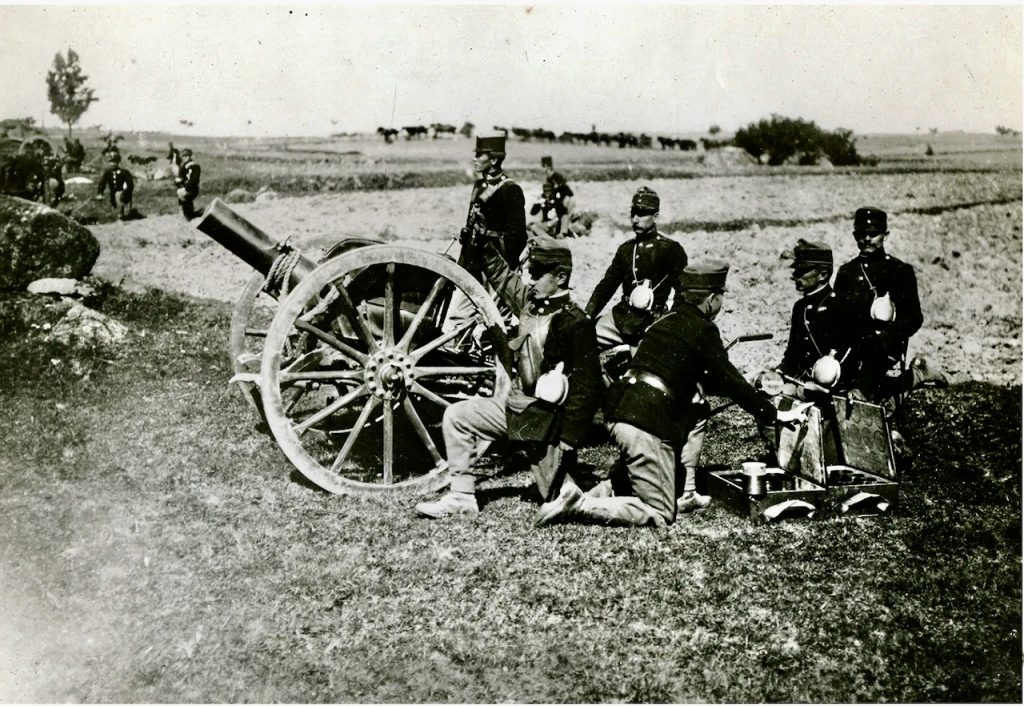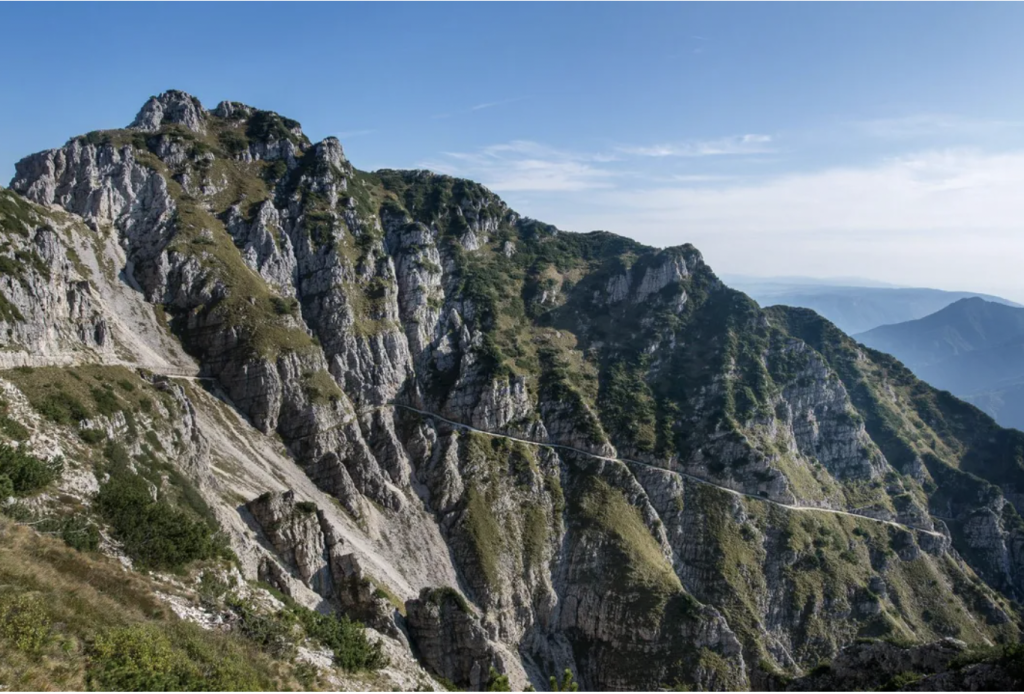POWs INCARCERATED RUSSIA 1914-1922
THE EASTERN FRONT WW1
HISTORY OF AUSTRO-HUNGARY EMPIRE
We all know the history of WW1’s Western Front, but so few of us know about the Eastern Front.
The Eastern Front stretched from the Baltic Sea in the north to the Black Sea in the South more than 1,600 kms and more than twice as long as the Western Front. Most of the fighting on the Eastern Front took place between allied Germany and Austro-Hungary against the Russians who had supported Serbia. It was every bit as bloody and more as the Western Front with millions of captured soldiers dying of exposure, starvation and maltreatment Atrocities against civilians included massacres, beheadings, mass rapes, murder, starvation, tortures, arson, pillaging, abduction of women and girls and internment under the most brutal conditions.
Smaller religious and ethnic populations were particularly vulnerable. There was the burning of whole villages and ethnic cleansing.
There was trench warfare but never a continuous trench line along the entire Front. Unlike the Western Front, there were large-scale offensives which covered 100s of miles but there were also extended lulls. Massive days-long artillery bombardments killed thousands. Warfare in the open field led to enormous numbers of losses – both military and civilians. Civilians suffered more in the East than the West. Millions of civilians were caught in shifting battle fields in the Baltics. Poland, Galacia and Romania leaving large numbers of dead, injured, displaced persons and evacuations.
Retreating from advancing German army, the Russian soldiers ran and adopted a scorched earth policy which left millions of Russian civilians without food for several years.
The Germans also adopted scorched earth policies in several locations. Those who suffer the most are the civilians.
It is difficult to even begin to imagine what life was like.

There was only one mountainous region but many formidable water obstacles of substantial areas, including wetlands, rivers and lakes. In East Prussia and Poland there were vast areas which were heavily forested. The Carpathians were heavily wooded.
Most essential in the Eastern Front was communications and logistics – Germany had an efficient rail system, Austro-Hungary’s rail was reasonable, however Russia’s was vastily undeveloped. The Russian general staff had prevented road or railway construction in the north and southeast of the Polish salient in order to provide protection to a defensive position in the centre of the salient.
In contrast to Britain and France the war destabilized the German, Austro-Hungarian and Russian governments and social systems.
Below: The massive size Empire of Austro-Hungary Empire 1914

The Beginning of WW1 & Austro-Hungarian Empire
On the 28th of June 1914 at Sarajevo the capital of Bosnia Herzegovina then part of the Austro-Hungarian Empire, Franz Ferdinand – heir to the Austro-Hungarian throne with his wife Sophie were assassinated. He was nephew to Austro Hungary’s head of state, Franz Joseph 1 Emperor of Austria and King of Hungary.
Relations had been tense between Austro-Hungary and Serbia. Austro-Hungary had annexed Serbia in 1908 and saw Serbia as a threat to the stability of its multi-ethnic empire. Serbia had ambitions to unify south-east Europe’s Slavic people. Following the Balkan War of 1912-19123 Serbia emerged a larger and more assertive country in south-east Europe.
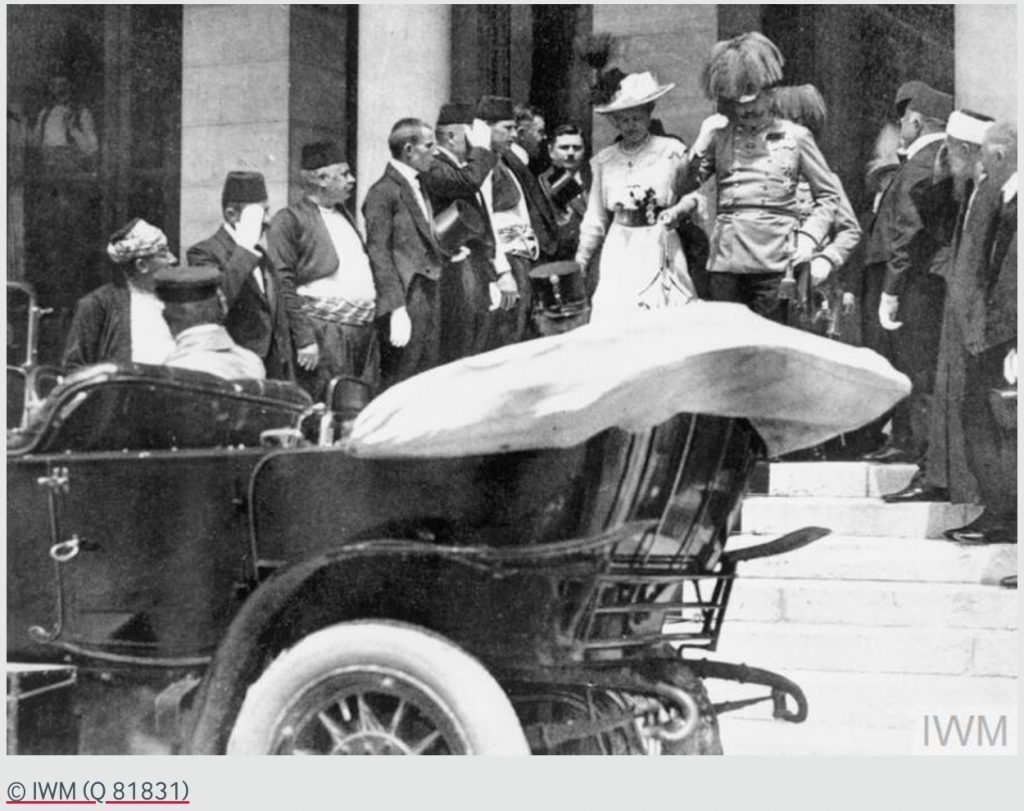
France Joseph 1 divided his empire into the ‘Dual Monarchy’ as it was sometimes referred to in which Austria and Hungary coexisted as equal partners. Before WW1 Austro-Hungary was the largest political entity in mainland Europe it spanned almost 700,000 square kilometres and occupied much of central Europe from the mountainous Tyrol region north of Italy to the fertile plains of Ukraine to the Transylvanian mountains of Eastern Europe.

Above: Franz Joseph 1 – he died 1916 following 68 years as leader.
11 major language groups were scattered across the empire of Austro-Hungary: Germans, Hungarians, Polish, Czech, Ukrainian, Slovak, Slovene, Croatians, Serbs, Italians and Romanians.
In 1879 Franz Joseph 1 formed an alliance with Prussian led Germany. Following the assassination of his nephew with whom he had not got along with, Franz Joseph 1 with the guarantee of Germany’s backing was forced to issue Serbia an ultimatum leading Austria and Germany into WW1. Russia’s support of Serbia brought France into the conflict. Germany declared war on Russia on the 1st of August and France on the 3rd of August 1914.
WW1 POWS TAKEN TO RUSSIA 1914-1922
Austro-Hungry anticipated winning against Russia who had stood beside Serbia. Russia was not prepared for war – fresh in their memories was the Baltic War and Russo-Japan War. A total of 15,300,000 Russians were called up into the army and navy. The army a mass of Russian peasant soldiers.
Initially that was not the case. Russia surprised all and defeated Austro-Hungary during the first years and thousands of soldiers were captured by Russia. Austro-Hungary was reliant on Germany for support and often leadership. Large numbers of Russians were also captured.
The story of World War 1 POWs sent to Russian camps is complex and spanned almost eight years from 1914 until 1922 when the last POWs were repatriated.
Prisoners of War (POWs) created acute problems for the Russian Empire from the earliest days of WWI. Successful offensives against the Austro-Hungarian Empire in summer of 1914 produced a flood of Austrian prisoners.
Many of these Austrian soldiers were of Slavic origin: Poles, Czechs, Slovaks, Croatians and Serbs. They had little loyalty to the Austro-Hungarian Empire and its rulers. They viewed the war between the Russian Empire and Central Powers in ethnic terms as a confrontation between the Slavic and German worlds, and they were definitely on the side of the former. Slavic soldiers surrendered to Russian troops en masse, and later as POWs joined the Russian forces.
The Russian leadership looked favourably upon Slavic POWs. They were predominantly housed in camps in the western part of the Empire and were mostly put to work in agriculture whereas the Germans, Austrians and Hungarians were often sent beyond the Urals to Siberia for exhausting work in mines and construction projects and inevitably death.
Surprisingly Russia treated POWs better than other belligerent nations. It willingly adopted initiatives to make the lives of its POWs better and actively cooperated with international organisations. Good treatment didn’t guarantee good conditions as well. Thousands of POWs died from the hunger, from typhus epidemics and different illnesses, since no proper living conditions were established for them.
In addition to fighting WW1 Russia underwent major political turmoil beginning with November 1917 Russian Revolution (an armistice was signed by Russia and Germany 15 Dec 1917 ended WW1 hostilities) and followed by several different governments with varying policies regarding POWs. In addition to the volatile political landscape, geographical circumstances played a major role in the lives of POWs who were incarcerated in camps spread from central to eastern Russia including Siberia, Central Asia as well as Ukraine . Climatic conditions were harsh and away from the main cities, infrastructures were barely developed. With political and social turmoil came starvation for both civilians and POWs. Add to this the large numbers of nationalities and languages of the POWs.

Above: Galacia 1914 – today the eastern half of Galicia is part of Ukraine, and the western half is part of Poland.
Below: Germans moving army supplies through Galacia and what is known as Ukraine today.


Above: German & Austro-Hungarian officers.
Between 23 August and 11 September 1914 at Galacia, part of the Austro-Hungarian Empire at the Battle of Lemberg, Russia severely defeated the Austro-Hungary armies, forcing Germany to send reinforcements to support its stumbling Austrian ally. Between 100,000 to 130,000 Austro-Hungarians were captured, 220,000 wounded and 100,00 dead. Russia lost 225,000 men of which 40,000 were captured.
(For comparison you may like to think about total of about 80,000 to 85,000 British, Indian and Australian POWs were taken at Fall of Singapore. In addition a further 50,000 men were captured in Malaya. Australia had 15,000 troops captured at Singapore and a total of 22,000 taken POWs of Japan).

Above: at Przemysl in 1915 cost 800,000 lives. 115,000 total Austro-Hungarian casualties (40,000 casualties were sustained in the first few days of the siege.) The Siege of Przemyśl was the longest siege in Europe during the First World War. It was a crushing defeat of Austro-Hungarian Army by the Russian Army.
Most Austro-Hungarian POWs were captured in Galacia 1914 (today the eastern half of Galicia is part of Ukraine, and the western half is part of Poland), at Przemysl in 1915 and the Carpathians in 1916. Slavs (ie. Poles, Ruthenians (Russians, Ukrainians, Slovaks or even Slavicised Hungarians), Czechs, Slovaks, Serbs, Croats , and Slovenes – from Slovenia) made up one half, ethnic Germans and Hungarians each around one quarter. Italians and Rumanians constituted the rest.
The second largest group of POWs were from the German Army. At least 168,000 soldiers were captured including small numbers of ethnic minorities such as Prussian Poles, Danes from Northern Schleswig and Alsatians.
The POWs’ nationality played a significant role in the location of their designated camps and treatment. Privileges included being imprisoned in European Russia (i.e. western Russia) – offering greater freedom and superior accommodation to encourage defection into the Russian army.
Russia could handle small groups of captures POWs and they were treated in an orderly fashion. However huge numbers of captured such as the Austo-Hungarins in 100s and 1000s suffered with Russia’s organisation deficits. Once captured POWs travelled between 1-3 months before reaching internment. They were interrogated and the wounded singled out for treatment (details unknown and unimaginable!). The remainder were marched to the rear where trains took them to the main assembly stations in Kiev and Moscow. It was here the POWs were registered and appointed to their place of internment according to their nationality.
They were piled into ‘teplushki’ so-called ‘warm-wagons’ used for transporting Russian soldiers. Each wagon was fitted with 2-3 rows of bunks, a stove and latrine bucket. Despite their name these cars were cold in winter and unbearably hot in summer. Of course most were loaded beyond capacity carrying 30-40 men ridden with vermin increasing disease.
This was only the beginning of their horror captivity.
Their makeshift quarters were overcrowded, many without sanitation facilities and no running water. During the early stages of the war, disease killed thousands of POWs, notably in the camps of Omsk, Novo-Nikolaevsk, Sretensk and Totskoe. Russian authorities failed to grasp or act during those early years until enormous death tolls and growing international pressure forced the Russian government to eventually develop a camp system and improved living conditions.
By 1917, Russia had more than 400 POW internment facilities. The size of POW camps was usually smaller in European Russia (between 2,000 and 5,000 men) than in Siberia (up to 35,000 men).
This war was just as horrific for the Russian Army – after 1915 and several defeats there was bitterness and talk of treason amongst officers and soldiers. Trench life for Russian soldiers throughout the Eastern Front running through the Baltic provinces, Poland, Belarus, Galicia and Romania was described as an inhuman experience.
‘Having dug themselves into the ground, they live in rain, snow and filth in cramped conditions, worn out by disease and eaten by vermin they live like beasts’ wrote Maxim Gorky.
The Russian army was desperately short of ammunition, many lacked shoes and resorted to ‘bast shoes’ made from birch trees. (Please read further the importance of shoes) The Russian Casualty clearing stations at the WW1 front were found to be almost as primitive as those in the Crimean war.
Attempts to modernise the Russian army had failed.
A senior Russian doctor wrote 25,000 gas masks arrived-tried and tested by their supreme commission. The doctor carried out a test by putting the masks on several medical orderlies. Two minutes later they began to suffocate.
How could they equip the men in the trenches?
Russian soldiers wrote home about being outgunned by German artillery, the callousness of their officers towards them and contrast in conditions for men and officers. Officers were paid considerably more, had access to better and more food, alcohol, prostitutes ** and far superior quality uniforms while their men were often starving.
Front line peasant soldiers knew they were cannon-fodder. They hated the war, the mud, the lice bad food and scurvy and the officers. Deliveries of food stuffs arrived filled with rotting hams and sausages. In Oct 1916 a report found appalling sanitary conditions, soldiers living in mud which reaches their wait, no shelter from bad weather, no warm clothes, no hot food or tea.
In addition to the above misery, inexperienced reinforcements arrived and were immediately ordered into a bayonet attack – but they did not want to die! Military authorities suppressed news of mutinies which were ruthlessly put down. Russia was collapsing.
** There was obsessive talk about officers setting up Red Cross nurses into brothels for their use only – although overall this was untrue, apparently in some locations this did occur.
The ordinary soldiers were not allowed to see their wives at all.
Officers offered women students in Odessa hundreds of roubles for photographs, what would they offer for visits?

War on the Eastern Front ended at the end of 1917 with the Russian Revolution, but most POWs in Russia’s east remained imprisoned.
It is estimated Russia captured 2.4 of the five million soldiers who fell into enemy hands on the Eastern Front – 90% of those captured came from Austro-Hungary. More than a 1/4 perished.
Below: Captured Serbian soldiers from Austro-Hungary WW1
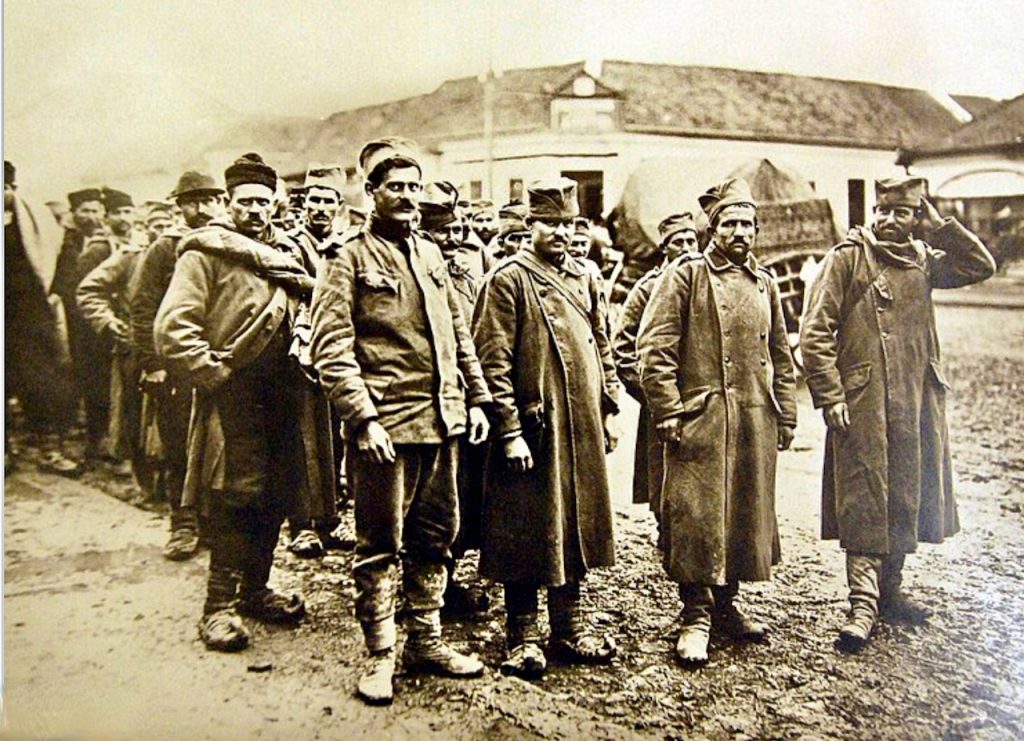

1917 A wounded Hungarian cavalryman walks next to his horse, leaning on its neck. In the background, several Hungarian cavalrymen ride past through a wooded area. In the top right corner, a vision of a woman and child kneeling and praying at a man’s bedside. text: GARAY SCHROMOLITHOGRAFIA Seidner PLAKAT UND CINKEGYÁR BUDAPEST. A VILMOS-HUSZÁROK MÁRCIUS. 11. ÉN MÜVÉSZESTÉLYT RENDEZNEK AZ OPERÁBAN ÖZVEGYEIK ÉK ÁRVÁIK JAVÁRA [Coloured lithography Seidner’s Poster and Labels Factory, Budapest. The Wilhelm Hussars present an artistic soirée on 11th March in the opera for their widows and orphans. Believed to raise funds for widows and chlldren.
Above: a full-length depiction of a Hungarian infantryman, holding a walking stick in his right hand and a bouquet of flowers in his left hand. A young woman, dressed in a ballerina costume, holds on to his left arm and carries a hat in her left hand. text: FARAGÓ GÉZA. ATHENAEUM R.T. BUDAPEST [Athenaeum Plc. Budapest]. From IWM.
Below: The fortunate walking wounded returning home.
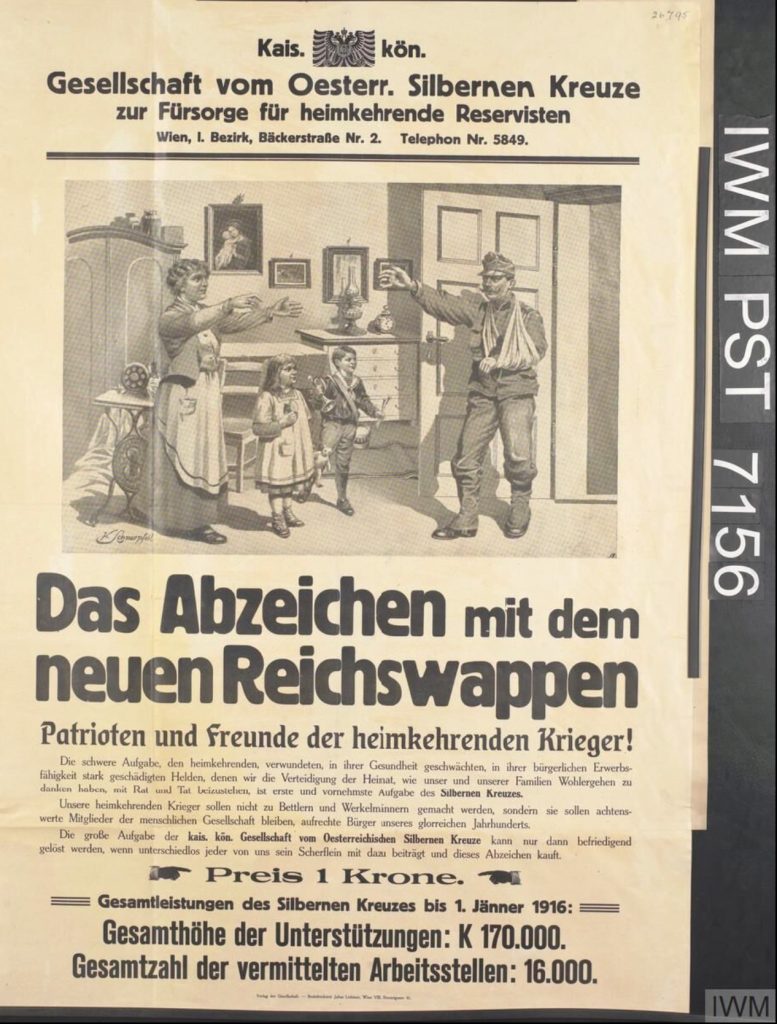

Above: a team of horses pulls an artillery gun up a snow covered hill. An Austro-Hungarian soldier grabs one of the wheels to help. Another soldier lays dead on the ground, his rifle by his side. Friday, 19 April 1918, at 7 p.m. Charity Academy for the benefit of the Widows and Orphans Fund of the Imperial and Royal Field Artillery Regiment, no.104 (formerly F.A.R. no.4) and the TB Patients Welfare of the Patriotic Relief Association of the Red Cross for Lower Austria. Cast: [a list of participants]. Music: band of Imperial and Royal Infantry Regiment, no.4, Grand and German Masters (Conductor, W. Wacek). Wars are very expensive. Regular benefit concerts are held.
The armies on the Eastern Front were all conscripts – requiring approx 3-4 years service followed by several years in reserve formations.
In 1914 Russian Army consisted of 102 regular divisions divided into 6 field armies. A total manpower of 1.4 million. The typical Russian infantryman was noted for his discipline and bravery but lacked leadership. Their army did not possess a depth of officers and senior enlisted men to choose from. There were few officers to replace those who had fallen. The Russian army had failed to efficiently produce reserve officers. Russia lacked artillery and was weak with technology. It fielded large masses of cavalry which strained the communications and logistical systems. It could only hope to gain an advantage over German forces by weight of numbers.
Below: Russians Troops WW1



Below: Russians & equipment captured Tannenberg where the German Army defeated the Russian Empire, capturing over 90,000 prisoners of war.

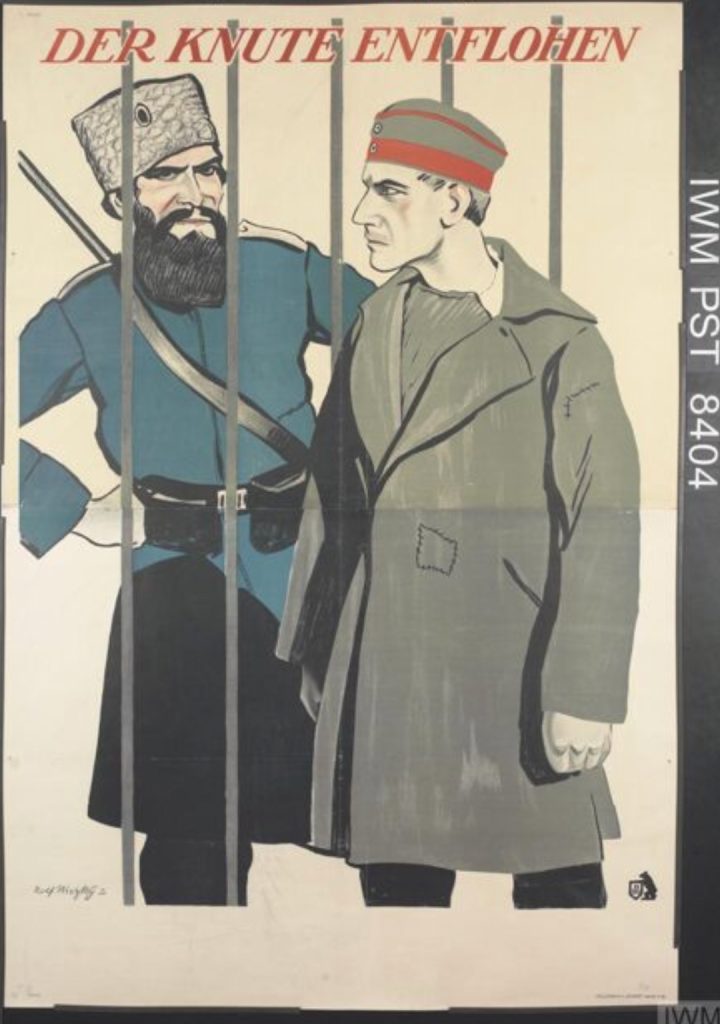
Below: Russians in khaki and Austro-Hungarians in Blue.

Germany’s eight field armies consisted of 98 regular divisions, supplemented by 27 Landwehr (reserve) brigades totalling 1.9 million – to be deployed to two Fronts. Germany’s army was well disciplined and trained and well-armed. Its railway network made it possible to move eight divisions simultaneously from the Western Front to the Eastern Front in 4 ½ days. Germany had effective military traditions and system of command. Her officers were skilled in directing a war of movement and were quick to exploit flank attacks. They were also capable of successfully directing operations of large formations.

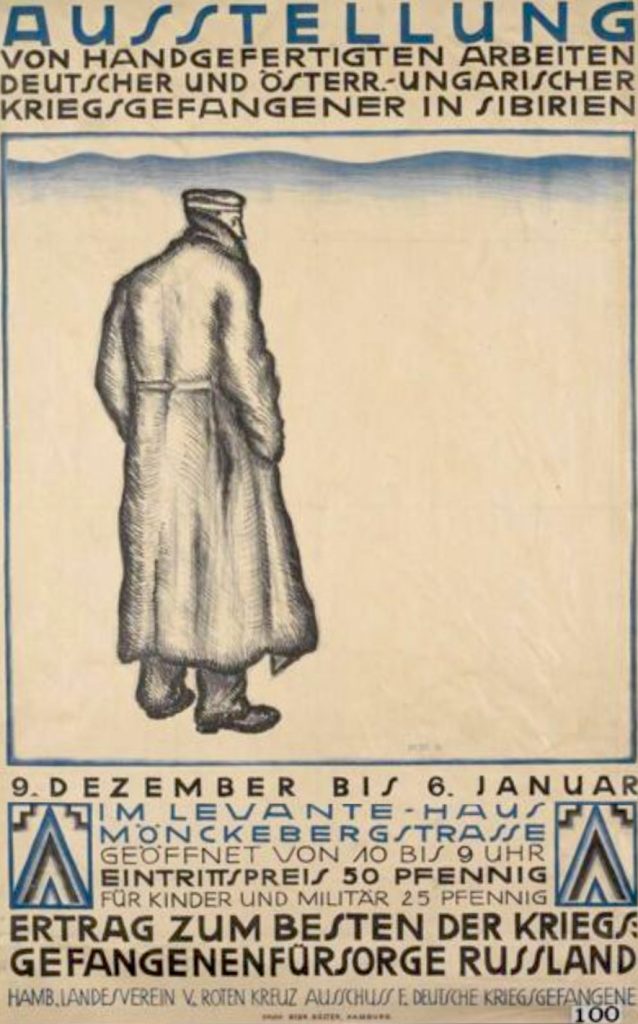
Above: German POW in Russian Camp – Siberia. Poster raising awareness and donations for ‘Benefits for the POWs in Russia’ by Red Cross in Hambourg. From IWM
Austro-Hungary mobilised around 8 million soldiers. Its senior officers were said to be mediocre at best. Its troops performed better when under German command. Its army was inferior to Russia in fighting quality. Although a powerful modernised army, its effectiveness was undermined by internal political and ethnic divisions such as language barriers between officers and their men. Their officers spoke German, leading non-German speaking soldiers. 1.016,000 (12.7% ) died, 1,691,000 were missing (21.1%). Around 2.1 million Austro-Hungarians were captured by Russia.
Below: Austro-Hungarian soldiers

Above & Below: Austro-Hungarians

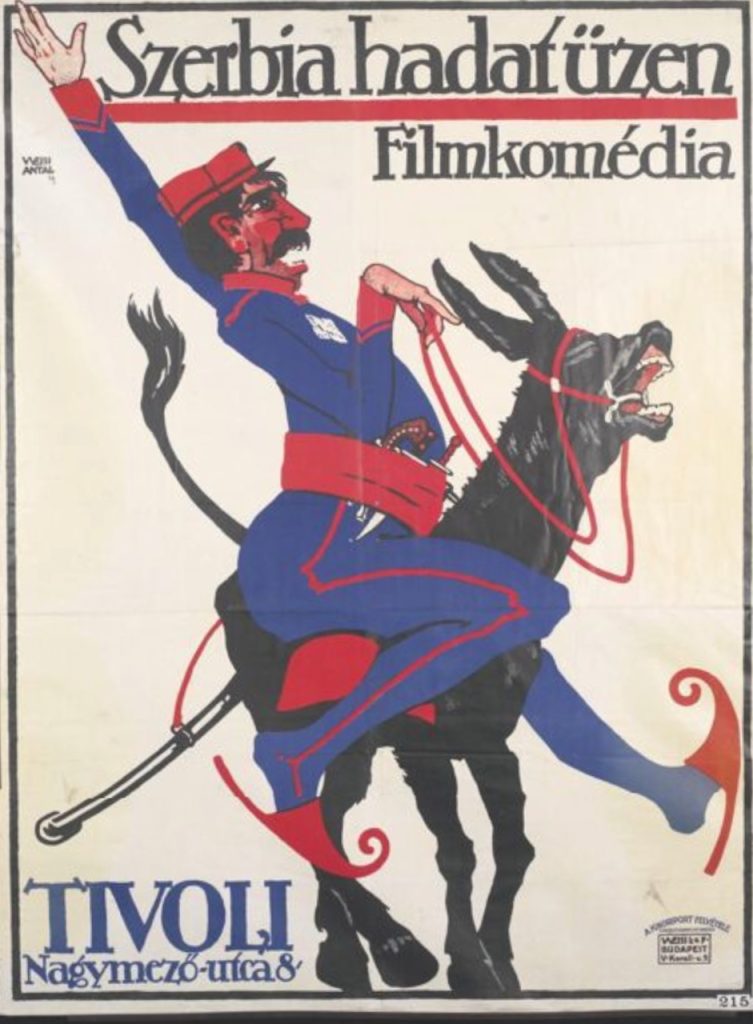
Above: caricature of a Serbian soldier riding on the back of a small donkey. He has two knives and a pistol in his waistband and raises his left arm. text: Szerbia hadatüzen Filmkomédia WEISS ANTAL 14 TIVOLI Nagymezö-utca 8. A KINORIPORT FELVÉTELE A PROJECTOGRAPH R.T. KIADÁSA WEISS L. és F. BUDAPEST V. Korall-u.9. [Serbia declares war. A movie comedy. Tivoli Nagymezo-utca 8. Filmed by Kinoriport. Released by Projectograph R. T. Weiss L and F. Budapest V. Korall-u. 9. We wish to Acknowledge IWM.
Above: Russian Orthodox Priest with Eastern Front Wounded – at this time, medicine and treatment could be primitive especially in remote the countryside of many countries. For the wounded there would have been little hope of surviving.
‘In Austria-Hungary, around 50 large prisoner of war camps were built in the course of the war as well as officer stations for captured officers, internment and work camps. However, the Austro-Hungarian military authorities underestimated the sanitary, hygiene-related requirements for the large camps. The typhus epidemic that raged through various Austro-Hungarian camps in the winter of 1914/15 (e.g. in the Mauthausen camp or at Marchtrenk in Upper Austria) illustrated the failings in dramatic fashion. In Mauthausen several thousand captive Serb soldiers died in the early months of the war.’
“Here it is even worse, we have to work when it is state work we are forced, we have a railroad chief – leader, he is a beast, forcing and dragging us to work, no matter if you are healthy or sick. If you stay home sick, you are just as miserable, as the barracks are so cramped and humid that you cannot sleep at night and they are very unhealthy. Do not be afraid, we will remain what we are: faithful sons of the homeland for which our blood was spilt.”
Galicia, Carpathians, two names that were most often mentioned at the beginning of the Great War in the newspapers or discussions in families when there were no news and only the questions “Fallen or captured?” remained. After long months, first news arrived. The first combat on the Russian front against the Russians in Galicia claimed more than half of the men and officers of the 17th Slovenian Infantry Regiment (Carniolan Johns – typical Slovenians; Kranjski Janezi), and in the next battles, Austro-Hungarian Army had more wounded than fighting soldiers. Many Slovenian soldiers became Russian prisoners of war. Around 2.1 million Austro-Hungarian soldiers were captured by the Russians during the War; the number of Slovenians is unknown.
The following is taken from Prisoners of War (Russian Empire)
‘The number of prisoners in Russia’s camps often fluctuated, POWs tended to be moved repeatedly between camps. These consisted of log or brick barracks, zemlianki (huts dug into the ground), or other buildings such as stables and warehouses. Soldiers’ barracks varied greatly in size, holding between 500 and 1,000 men, notably fewer in the case of officers. According to Elsa Brändström’s WW1 experience “rooms were overbooked by 50-100 percent without exception.” Furniture was scarcely provided beyond bare bunks and stoves for heating.
Everyday life was very different for the rank and file than for officers. Officers received a monthly salary from which they had to procure their own food and other necessities, initially allowing them to get by comfortably. Their standard of living was described as “considerably higher than that of their home states’ civilian population.
The food for enlisted POWs was provided by the detaining power. At the outset, quantities were ample, equalling those of the Russian military, but soon both the quality and quantity of food deteriorated. Many men were repulsed by the fact that they had to share their bowls, as was customary in the Russian military. While officers were allowed orderlies, the soldiers themselves were in charge of the upkeep of their camps. Suspicious of the POW officers’ authority, regulations were introduced in 1915 segregating them from their men.’
Below: German POWs working in Siberia.

Below: starving POWs in Russia WW1. Our thanks to IWM.


Above: POWs

Above: Russian peasants become refugees.
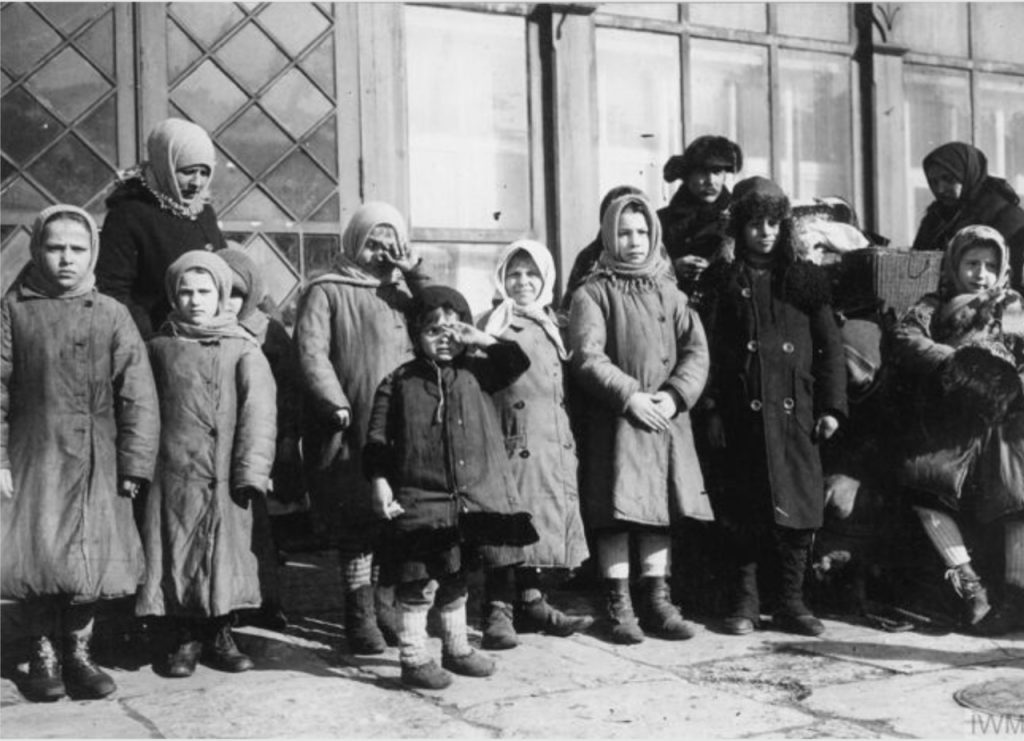
We wish to acknowledge IWM. Above civilian Russian refugees who have escaped horrors of Bolshevik Revolution.

Above: IWM Donate books for our prisoners in enemy countries. Money donations for the purchase of reading material for our prisoners of war in enemy countries, very longingly asking for them, are very gratefully received in return for the issue of a commemorative sheet after the above drawing at the price of 1 krone, and an original etching by Professor Ferdinand Schmutzer after the same drawing at the price of 50 kronen. Overpayments will be expressly acknowledged. A. Berger Lithography Office, Vienna VIII.
On 14 August 1918 Emperor Karl and Kaiser Wilhelm met at the German headquarters in the Belgian. The German Chief of General Staff Hindenburg and deputy Ludendorff for the first time stated the obvious: the impossibility of ‘victorious peace’.
They disagreed on how to proceed. Austria wanted immediate peace negotiations however Germany wanted continuation of hostilities – they wanted more time to create a status quo giving them an advantage at the peace negotiations.
The Austrian Emperor Karl (who replaced Franz Joseph in 1916) rejected a further offensive on the Italian from or in Rumania. They faced catastrophic consequences.
The summer of 1918 had seen the failure of a massive German offensive which had aimed to drive back the French and British armies before the Americans landed.
This resulted in the Central Powers (Germany, Austro-Hungary) exposed to the full force of the US Army leading to the collapse of the German front line at the beginning of Oct 1918. Nor were they strong enough to resist the advance of Allied troops on the Balkan front.
Austria’s situation in the Italian theatre of war was far more desperate – supply shortages and lack of military equipment meant the Austrians were hardly able to function. General exhaustion also led to a break-down of discipline. Desertion had long been a major problem. Now generals were confronted with mass desertions and by the end of summer 230,000 men had abandoned Austro-Hungary army. At the same time there was a break-sown of authority in Austria’s states. Political resistance was more public and violent rioting had increased.
There appeared to be no preventing the collapse of the Dual Monarchy, Emperor Karl and his government were witnesses to a massive acceleration of the disintegration of Austro-Hungary empire.
On 26 October 1918 Karl finally dissolved the alliance with Germany in a telegram to Kaiser Wilhelm followed by a comprehensive offer of peace to the Western Powers. By now the Austrian army was already falling apart and the Hungarian government recalled the Hungarian regiments from the Italian front. The chaos which followed led to the final breakdown of the military command structure, mutinies and disobedience in the ranks.
3 Nov 1918 the above disintegration resulted in Austria-Hungary concluding a ceasefire with the Entente Powers (an international military coalition of countries led by France, United Kingdom, Russia, the United States, Italy, and Japan). There were communications difficulties and Austria units laid down their arms earlier than was intended, resulting in 360,000 men being taken prisoners by the Italians during the last hours of hostilities.
After losing the war the Hapsburgs of Austria-Hungary were overthrown, Karl 1 refused to abdicate and was exiled to Madiera, Portuagal and Kaiser Wilhhelm II of Germany abdicated in 1918. Both countries became republics and both were heavily punished in the Treaty of Versailles in 1919.
The Empire of Austria-Hungary no longer existed.

Above: Emperor Karl of Austria
Below: House of Hapsburg-Lorraine. Where Karl1 resided.


Above: Imperial Court Vienna. ‘Karl’s office’ and official Rooms.

Above: The Ex Emperor Karls New Home in Madeira a Portuguese archipelago lying North of Tenerife, Canary Islands. His health declined and he died here.
Below: German Emperor, King of Prussia (15 June 1888 – 9 November 1918) abdicated in 1918 marking the end of the German Empire and the House of Hohenzollern’s 300-year reign in Prussia and 500-year reign of Brandenburg.
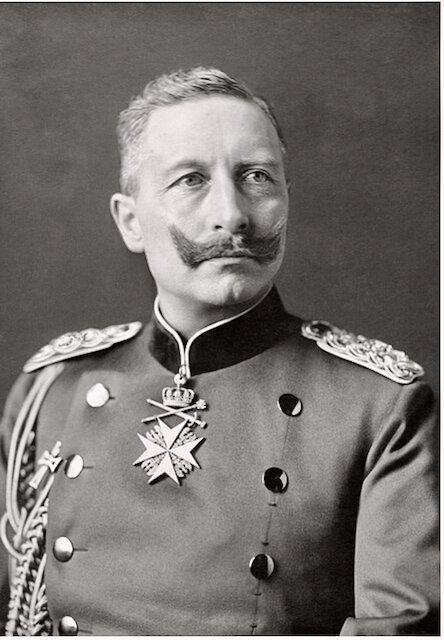
Below: Known as the ‘Old Palace’ Berlin and where Kasier Whilhelm resided.
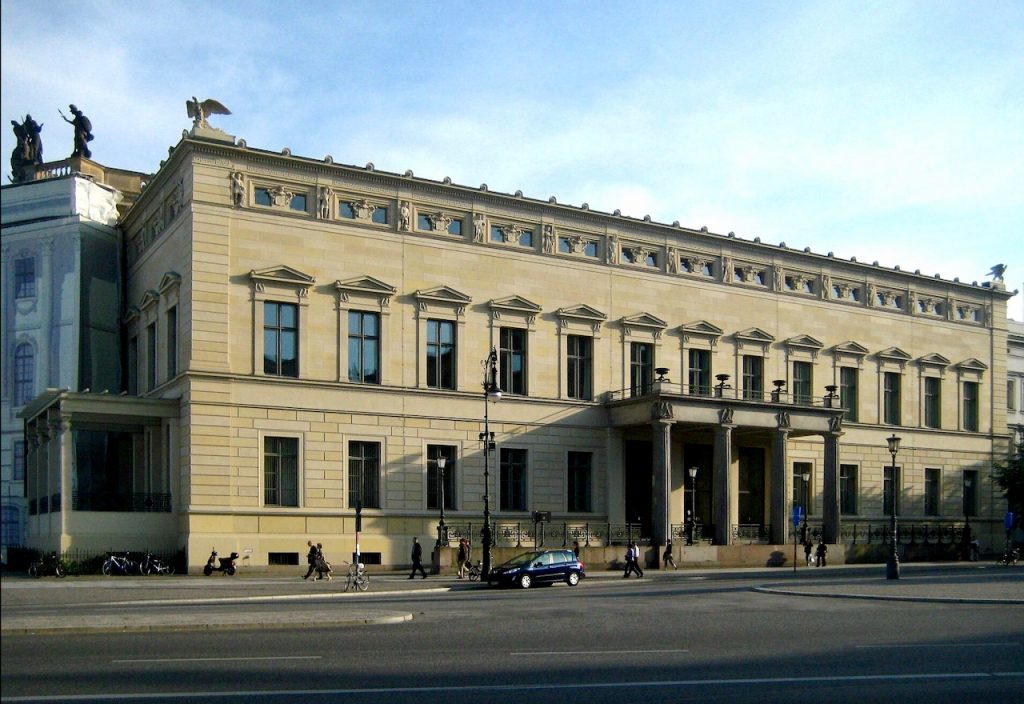
Below: The Berlin Palace (left) with the National Kaiser Wilhelm Monument to Wilhelm I (destroyed 1950), c. 1900.
This Palace was for official events and visitors.
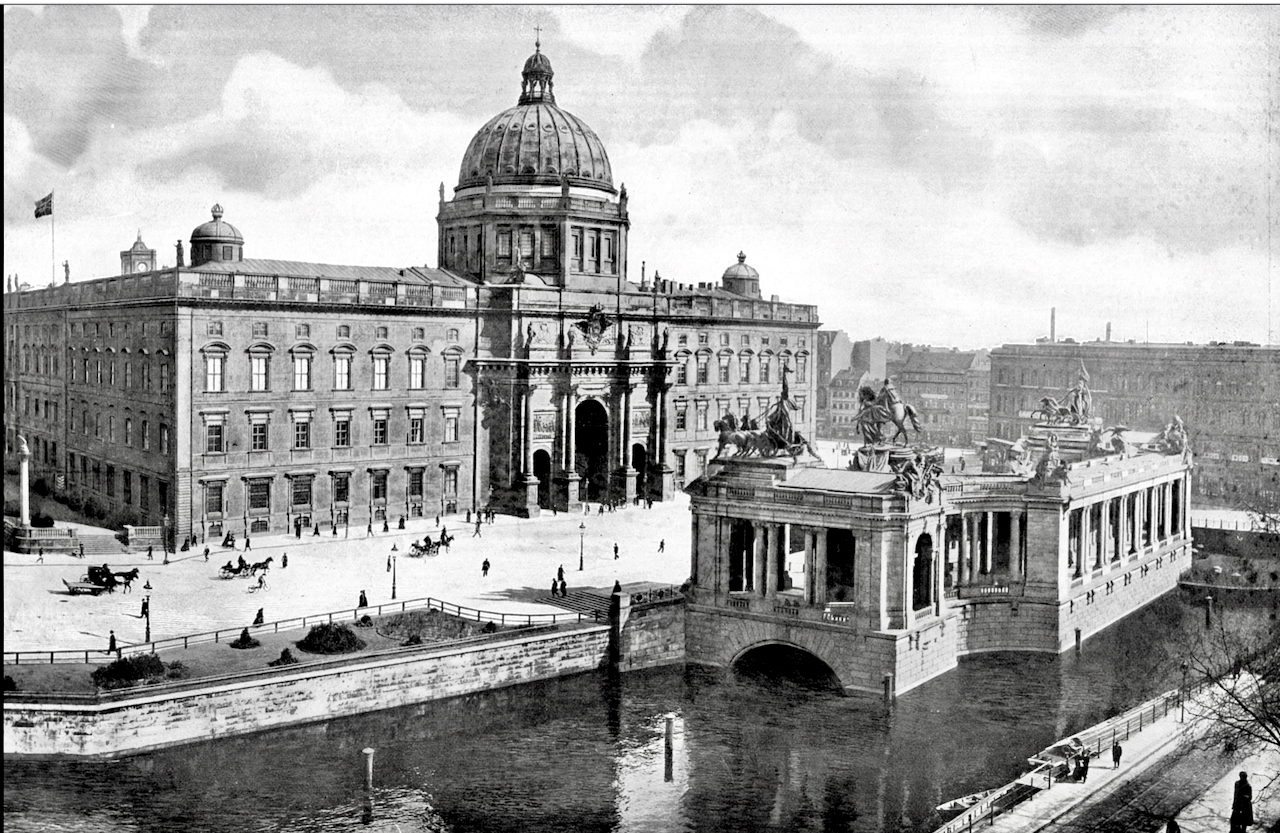

Above: Kaiser Whilhem’s house in Holland 1919-1941.
In 1922, the last 6,850 POWs were repatriated via Vladivostok, Russia. Between 1921 and 1922, 13,000 Austro-Hungarians returned home from southern Russia and Ukraine to a country they would barely recognise.
Please read about POWs in Russia during Revolution
From BBC – WAR AND REVOLUTION IN RUSSIA 1914-1921
1915-1917 War Between
Austro-Hungary
and Italy
Please read further about the battles fought in the alps.


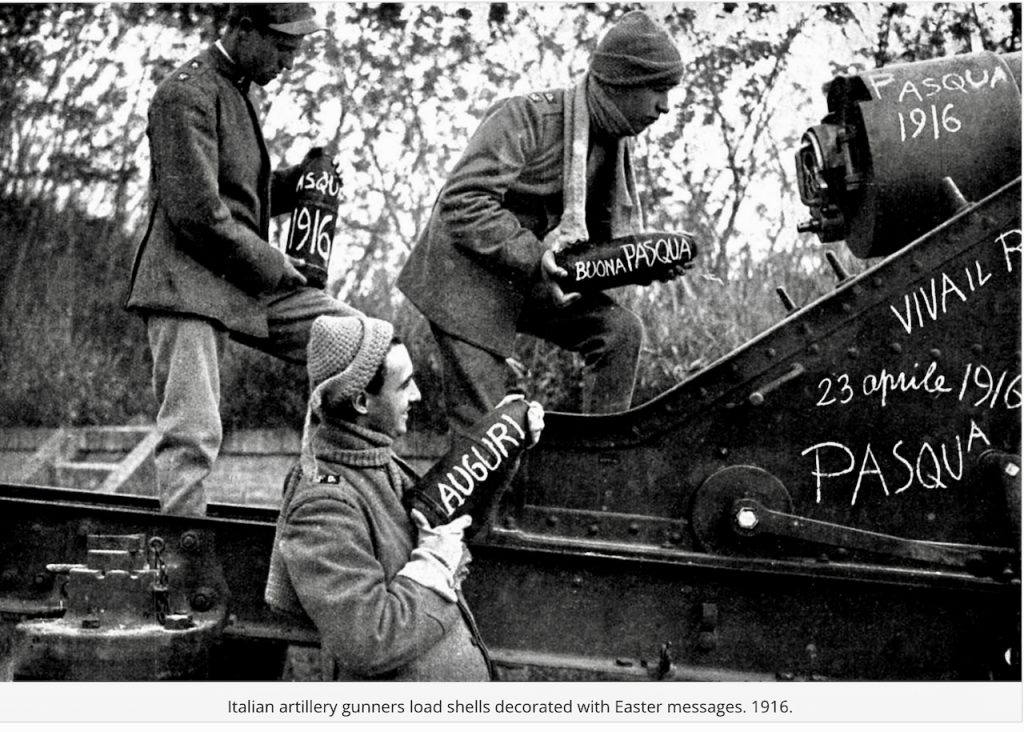
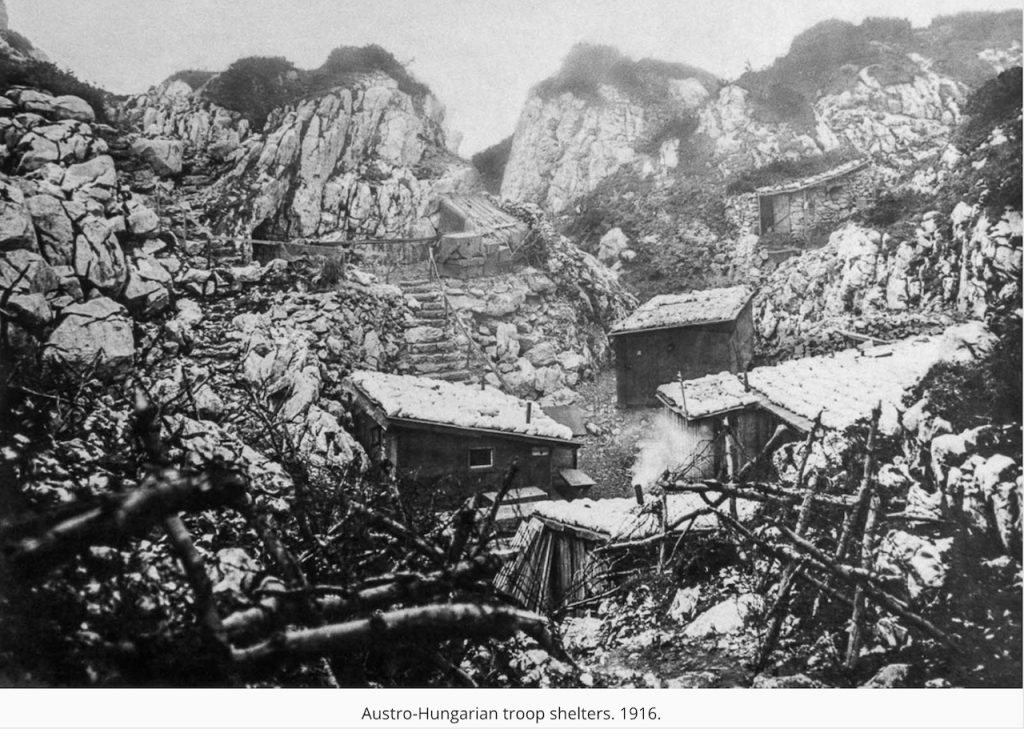


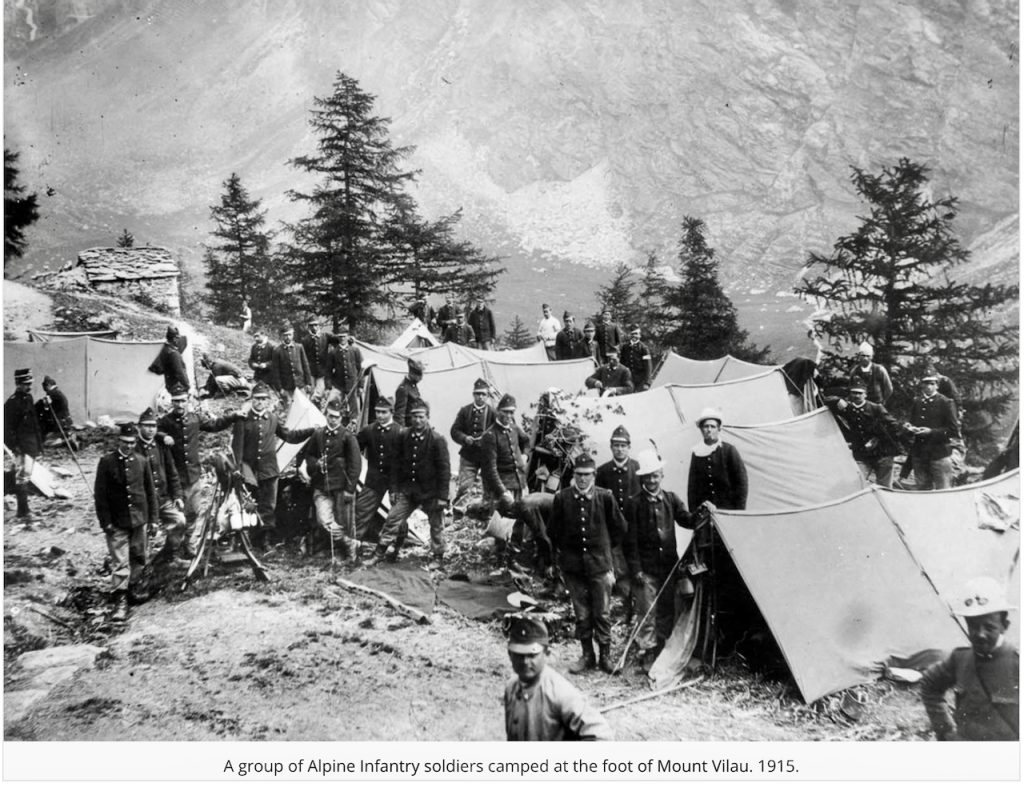

This war was very different, fought mostly high on the Italian Alps and known as ‘the White War’. It was also referred to as the Treacherous War. Soldiers often fought in precarious locations and always in the cold.
https://www.turismofvg.it/en/108682/action-on-the-ranges-of-the-pasubio



